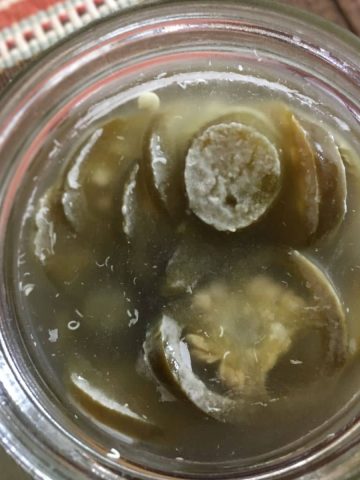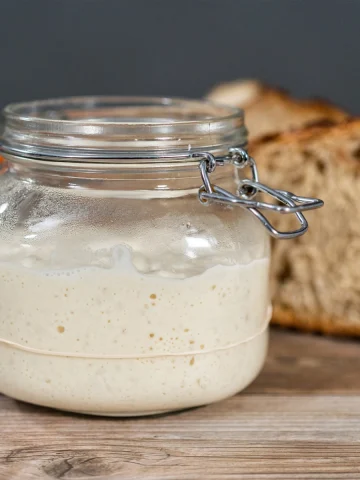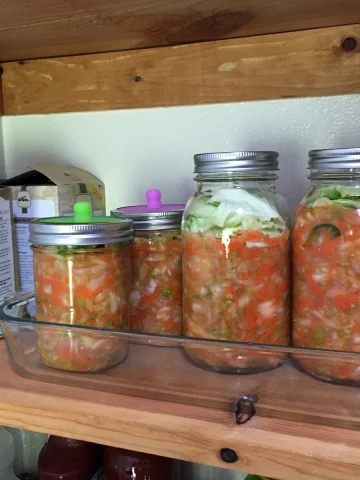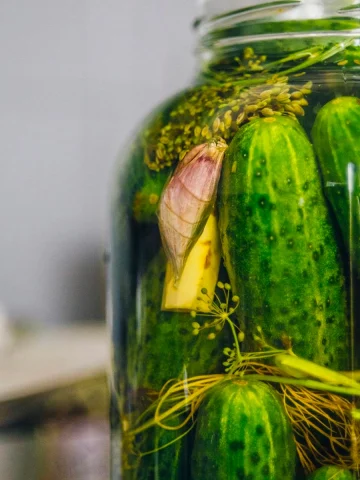When you are new to fermenting foods, the first time you see the fermentation process, it can look a little strange and iffy. Each batch you make will behave and ferment differently than the batch before, so it is possible that your fermentation will always look different.
Some people will throw out a perfectly good batch of sauerkraut or kimchi, thinking it has gone bad when it has not.
In this post, I will answer the questions “How do I know my fermented food is bad ?” and “Is my fermented food safe to eat?”
First, let's talk about what fermentation looks like. During fermentation, you will see bubbles bouncing around in the jar, and this is a good sign that the fermentation process is working.
Depending on the batch that you are producing, you may get a very high level of bubbles or a lower level. Some ferments might now show bubbles, which is okay.
It all depends on what you are fermenting, your ingredients, your temperature, and so on. One way to always check for healthy fermentation is to check it every 2-3 days.
If the color, smell, and brine levels are good, then you are good to go. Just remember that all fermentations will not look the same.
Before you start fermenting your food, do you know how to tell if fermented food is bad? Knowing how to spot if fermented food is toxic can save you a trip to the emergency room.
Below are several key ways to identify healthy or spoiled ferment at home. Most of the tips require you to be a little observant when opening the jar of fermented vegetables.
Fermented food from the market is always edible because manufacturers check the quality before distribution.
The tips below are for people who are making homemade fermented vegetables, such as sauerkraut, kimchi, jalapenos, carrots, and so on.
Signs That Your Fermented Food Is Bad
Simple signs signal that your fermented food isn't fit for human consumption. You can note when the food is bad when you are aware of the apparent signs of identifying toxic food.
Some signs are so evident that no one will have to tell you that you must throw a batch out.
Foul Smell
Harmful bacteria will produce a foul smell that you won't withstand, let alone put in your mouth. Beware that once you open a jar, there may be a foul smell as it releases gases.
Don't eat the food if the smell persists after the jar sits open for a while. The nose test is a simple way to identify inedible fermented food fast.
A Tip: Buy fermented foods from the grocery store to get used to a successful ferment's smells, colors, and textures.
Then when you make your own, you will have a strong base for knowing what a healthy ferment looks and tastes like.
Mold
It is important to check whether there is mold on the lid of the jar or on the top of the food. If the mold is brownish, pinkish, black, or any color other than white, the batch is wasted.
Mold development is a sign of contamination of the food during fermentation.
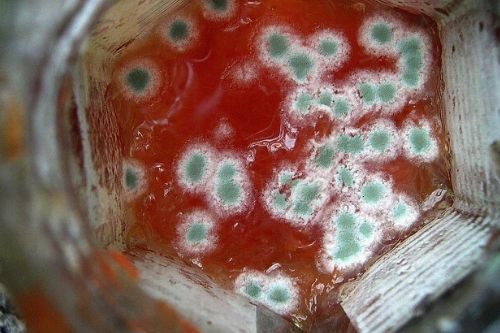
Keep in mind that mold only grows on the surface and will not penetrate the brine itself. Mold cannot survive in a salt brine.
If you spot a white and fuzzy substance, it is not mold; it is a type of yeast called Kahm. Kahm yeast is an aerobic yeast that forms when the sugar is used up and the PH of the ferment drops because of the lactic acid formation.
Kahm is easily mistaken for mold. Kahm yeast tends to show up on the surface of many fermented vegetables like pickles and sauerkraut in the warmer summer months.
Even though Kahm yeast has an odd unpleasant smell and looks weird, it is totally harmless. It is easily removed from a jar by scraping it off the surface of the vegetables.
Check the batch every day because it will return. If you think your ferment is ready, place it in the fringe; the colder temperature will stop the yeast from returning.
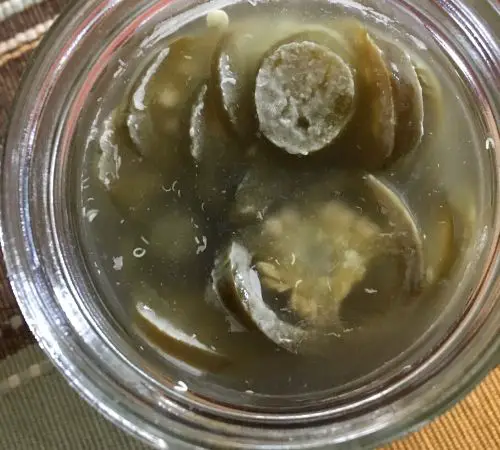
Color
Pay attention to the color of the vegetables you are fermenting. If you notice that the color is way off, such as bright green cabbage has turned gray, black, or brown, you shouldn't eat it.
Discoloration signifies that the food became toxic during fermentation. Healthy fermented food maintains color throughout the process.
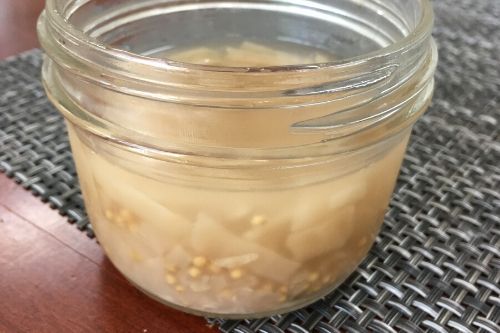

How To Prevent Fermented Food From Spoiling
Use The Best Quality Ingredients
As a rule of thumb, always start with fresh good quality vegetables. Sometimes, you can find that only a small portion of a fruit or vegetable is bad.
Cutting out the bad part and using the remainder for fermentation is highly tempting. However, it is possible to spread the spores from the bad parts.
The spores will then grow during fermentation and spoil the whole batch.
The best results of fermentation happen when you use the best ingredients from the start. Be highly selective of the food you use at the beginning.
Select the best and healthiest vegetables from the market or your garden and use those for fermentation.
Most fresh foods contain preservatives to increase shelf life due to companies spraying chlorine on vegetables to kill bacteria and maintain the freshness of the produce.
The food preservatives contaminate the contents of your jars and can lead to spoilage.
Washing the vegetable with filtered or well water before fermenting is an important step you do not want to leave out.
Preservatives interfere with the development of good bacteria when you are fermenting produce.
Here is a great article that goes into detail about sprayed produce.
Use Chlorine-Free Water
Treated water contains chlorine and other chemicals that may harm the good bacteria you try to cultivate during fermentation.
Chlorine kills a large percentage of bacteria in water, whether good or bad. Therefore, treated water can kill any useful bacteria you need in the fermentation process.
Unfortunately, treated water also contains hardy bacteria that can withstand chlorine treatment.
The hardy bacteria can outnumber the good bacteria and lead to spoilage of fermented food.
Your best bet is to use well water or filtered water to remove any traces of chemicals and chlorine.
Pure water is the best starter for a fermentation process. It allows you to create high-quality brine that will preserve the product during the whole process.
Another bad habit is washing produce with treated water or vegetable washing detergent, as it strips the vegetable of all the healthy bacteria.
A neutral liquid-like filtered or well water will remove any preservatives while maintaining the healthy bacteria. You can opt to shop at the farmers market and look for fresh, organic produce free of any chemicals.
Ferment In The Right Temperature
The optimal temperature for fermenting most vegetables is between 65-72 degrees Fahrenheit (17-22 Celsius).
Beware that extremely low temperatures can kill some of the good bacteria and higher temperatures will speed up the process and turn the food into mush.
During the summer, it can be hard to keep a temperature of 70 to 75 degrees. Look around the house for a cooler place to store the jars or crocks, like the basement or a low cabinet in the kitchen or near an air conditioner or fan.
Since higher temperatures can cause bacteria to be more active, it is important to check the jar regularly and beware that it can be done a few days before expected.
Often, recipes that normally call for 7 days can be ready in just 5 days.
Brine Strength
Weak salt brine can result in spoilage during the fermentation process. It is wise to start with a good amount of salt brine concentration to improve the chances of success.
Most fermented vegetable recipes recommend a 2.0-2.5% salt brine in relation to the weight of the vegetable mixture.
However, much documentation shows a lower level of 1.5% salinity will still make a successful batch.
Take a look at my post about Why sauerkraut gets too salty and how to fix it, to learn more about the levels of salt brine in fermenting.
Keeping the vegetables submerged below the salt concentration also plays a part in successful fermentation.
Check out my post Fermentation weights: how to keep veggies submerged for some easy tips.
Proper Cleaning And Sanitizing The Equipment
If you have canned, pickled, or made beer before, you are probably used to sterilizing your jars beforehand. But when it comes to vegetable fermentation, it’s a little less stringent.
You need the fermentation crock or jars to be free of chlorine, iodine/iodide, and any particles of food.
How to clean equipment for fermentation?
Clean them with hot water, dish soap, and a brush to remove debris. Or run them through the dishwasher. That's It!
If you want to take a step further, you can add a couple of tablespoons of bleach to the sink when you wash them out and let them soak for a few minutes.
Bleach kills everything. Just be sure to rinse them very well.
Signs Your Fermented Food Is Safe To Eat
There are signs that you can look out for to know whether your fermented food is safe to eat or not. The characteristics do not require you to have any special equipment to analyze the edibility of the food.
Smell
There is a mild fermentation scent that is associated with fermented food. If you have ever bought sauerkraut or kimchi, you can relate to that smell.
It should not have an overpowering smell that makes you feel like gagging.
Over time as you gain experience in making fermented food, you will be able to identify the good fermentation smell right away.
Therefore, you need to smell your fermented food jars before eating it.
Texture
Fermentation does slightly break down the food, but it should still have a little crunch to it. For example, if your batch of fermented carrots is soft and mushy, then it has gone bad.
All fermented vegetables should have a good texture. Be on the lookout for any that seem to have a hint of slime. Slime in food is a result of harmful bacteria, and you need to throw it out.
Think about the vegetables you use in the fermentation recipe and how naturally crunchy they are. The rib of napa cabbage has a good crunch to it, and so do daikon radish, carrots, apples, and garlic.
So if you are testing a batch of kimchi to see if it is done and the daikon radish is mushy, that is a clear sign the batch is bad, and you should check it out.
Has a Healthy Color
The fermentation process should not affect the color of the food or the liquid inside. Healthy fermented foods maintain their color throughout the process.
Therefore, when done, your cabbage should have a healthy green and white color. If the cabbage turns brown or gray, it is safe to assume that the food is not good for human consumption.
How To Tell If Sauerkraut Is Bad?
Because sauerkraut is one of the most popular fermented foods out there, I'll review how to tell if your sauerkraut is bad?
First, do the smell check; if it is pungent, then it is bad. A healthy version will have a sour odor that is pleasing.
Bad sauerkraut will produce a scent that curls your toes and makes you want to run out of the kitchen.
Next, is there mold or a fuzzy growth of any color other than white on the cabbage? It is safe to assume that your sauerkraut is bad. It would be best to dispose of it.
Is the color off? Here is an article about troubleshooting sauerkraut that has turned brown.
What if your sauerkraut is tasting a little too sour for your liking? First, don't throw it out. Second, check out these helpful tips on how to make sauerkraut less sour.
Last Word On How To Tell Fermented Food Has Gone Bad?
Learning the craft of fermenting vegetables at home can be so rewarding. Being able to provide gut-healthy food for your family and friends is empowering too.
However, at the beginning of trying a new way to prepare food, it is important to trust your instincts and take a few extra steps to prevent getting sick from eating any fermented food that has spoiled.
Most people are a little skittish about starting the process of fermentation for the first time.
Here are two excellent books that provide straightforward guides, delicious recipes, and step-by-step instructions that take the stress out of at-home fermentation.
Whether you are trying fermentation to improve your health or want to explore this time-tested culinary skill, these books will guide you in your journey.
As people rely on pasteurized and processed foods, we no longer consume enough natural probiotic sources.
Try adding more fermented foods (and healthy bacteria) to your plate.
Here are my guides on how and where to buy fermented foods with probiotics in the grocery store or online.
Not sure what to ferment first? Try one of our fermented vegetable recipes and enjoy your journey into fermenting.

